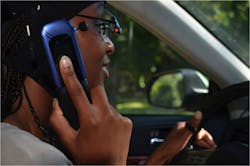Hands-free technologies, once thought to be a safer alternative for drivers than hand-held cell phones, actually are more distracting for drivers, according to a new study from the AAA Foundation for Traffic Safety. While such devices might make it easier for motorists to text, talk on the phone or even use Facebook while they drive, do we really want employees – or anyone – doing these things while driving?
The study from the AAA Foundation for Traffic Safety show dangerous mental distractions exist even when drivers keep their hands on the wheel and their eyes on the road. The research found that as mental workload and distractions increase reaction time slows, brain function is compromised, drivers scan the road less and miss visual cues, potentially resulting in drivers not seeing items right in front of them including stop signs and pedestrians. This is the most comprehensive study of its kind to look at the mental distraction of drivers and arms AAA with evidence to appeal to the public to not use these voice-to-text features while their vehicle is in motion.
Vehicle crashes already are the number one cause of fatal, work-related injuries. And crashes are the leading cause of death for everyone between 5 and 35 years old. About 100 people die every day on our nation’s roads.
The number one cause of car crashes is human error and driver distraction is the top human error. With a predicted five-fold increase in infotainment systems in new vehicles by 2018, AAA and the National Safety Council (NSC) are calling for action.
“There is a looming public safety crisis ahead with the future proliferation of these in-vehicle technologies,” said AAA President and CEO Robert L. Darbelnet. “It’s time to consider limiting new and potentially dangerous mental distractions built into cars, particularly with the common public misperception that hands-free means risk-free.”
Janet Froetscher, NSC president and CEO, said her organization “joins the AAA Foundation in urging the auto industry and policy makers to carefully evaluate all the research on this issue. We encourage these groups to reconsider the inclusion of communications and entertainment technology built into vehicles which allow, or even encourage, the driver to engage in these activities at the expense of focusing on driving.”
Measuring Brain Waves, Eye Movements
Cognitive distraction expert Dr. David Strayer and his research team at the University of Utah measured brainwaves, eye movement and other metrics to assess what happens to drivers’ mental workload when they attempt to do multiple things at once, building upon decades of research in the aerospace and automotive industries. The research included:
- Cameras mounted inside an instrumented car to track eye and head movement of drivers.
- A detection-response-task device known as the “DRT” was used to record driver reaction time in response to triggers of red and green lights added to their field of vision.
- A special electroencephalographic (EEG)-configured skull cap was used to chart participants’ brain activity so that researchers could determine mental workload.
- Using established research protocols borrowed from aviation psychology and a variety of performance metrics, drivers engaged in common tasks, from listening to an audio book or talking on the phone to listening and responding to voice-activated emails while behind the wheel.
Researchers used the results to rate the levels of mental distraction drivers experienced while performing each of the tasks. Similar to the Saffir-Simpson scale used for hurricanes, the levels of mental distraction are represented on a scale:
- Tasks such as listening to the radio ranked as a category “1” level of distraction or a minimal risk.
- Talking on a cell-phone, both handheld and hands-free, resulted in a “2” or a moderate risk.
- Listening and responding to in-vehicle, voice-activated email features increased mental workload and distraction levels of the drivers to a “3” rating or one of extensive risk.
“These findings reinforce previous research that hands-free is not risk-free,” said AAA Foundation President and CEO Peter Kissinger. “Increased mental workload and cognitive distractions can lead to a type of tunnel vision or inattention blindness where motorists don’t see potential hazards right in front of them.”
AAA Recommendations
Based on this research, AAA is urging the automotive and electronics industries to join them in exploring:
- Limiting use of voice-activated technology to core driving-related activities such as climate control, windshield wipers and cruise control, and to ensure these applications do not lead to increased safety risk due to mental distraction while the car is moving.
- Disabling certain functionalities of voice-to-text technologies such as using social media or interacting with e-mail and text messages so that they are inoperable while the vehicle is in motion.
- Educating vehicle owners and mobile device users about the responsible use and safety risks for in-vehicle technologies.
AAA also is using the findings to promote dialogue with policy makers, safety advocates and industry to ensure that these emerging in-vehicle technologies won’t lead to unintentional compromises in public safety. As part of this effort, AAA already has met with safety advocates and provided copies of the report to CEOs of all major U.S. automakers.
“This study constitutes the most in-depth analysis to date of mental distractions behind the wheel. AAA is hopeful that it will serve as a stepping stone toward working in collaboration with automakers to promote our shared goal of improving safety for all drivers,” said Darbelnet. “Specifically, these increasingly common voice-driven, in-vehicle technologies should be limited to use for just core driving tasks unless the activity results in no significant driver distraction.”
About the Author

Sandy Smith
Sandy Smith is the former content director of EHS Today, and is currently the EHSQ content & community lead at Intelex Technologies Inc. She has written about occupational safety and health and environmental issues since 1990.
